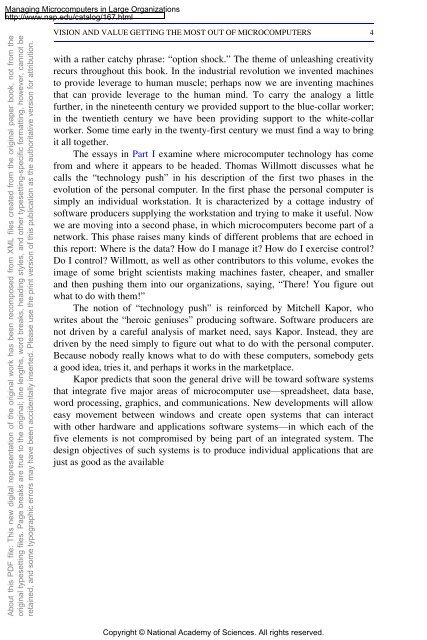Managing Computers in Large Organizations
Create successful ePaper yourself
Turn your PDF publications into a flip-book with our unique Google optimized e-Paper software.
<strong>Manag<strong>in</strong>g</strong> Microcomputers <strong>in</strong> <strong>Large</strong> <strong>Organizations</strong><br />
http://www.nap.edu/catalog/167.html<br />
About this PDF file: This new digital representation of the orig<strong>in</strong>al work has been recomposed from XML files created from the orig<strong>in</strong>al paper book, not from the<br />
orig<strong>in</strong>al typesett<strong>in</strong>g files. Page breaks are true to the orig<strong>in</strong>al; l<strong>in</strong>e lengths, word breaks, head<strong>in</strong>g styles, and other typesett<strong>in</strong>g-specific formatt<strong>in</strong>g, however, cannot be<br />
reta<strong>in</strong>ed, and some typographic errors may have been accidentally <strong>in</strong>serted. Please use the pr<strong>in</strong>t version of this publication as the authoritative version for attribution.<br />
VISION AND VALUE GETTING THE MOST OUT OF MICROCOMPUTERS 4<br />
with a rather catchy phrase: “option shock.” The theme of unleash<strong>in</strong>g creativity<br />
recurs throughout this book. In the <strong>in</strong>dustrial revolution we <strong>in</strong>vented mach<strong>in</strong>es<br />
to provide leverage to human muscle; perhaps now we are <strong>in</strong>vent<strong>in</strong>g mach<strong>in</strong>es<br />
that can provide leverage to the human m<strong>in</strong>d. To carry the analogy a little<br />
further, <strong>in</strong> the n<strong>in</strong>eteenth century we provided support to the blue-collar worker;<br />
<strong>in</strong> the twentieth century we have been provid<strong>in</strong>g support to the white-collar<br />
worker. Some time early <strong>in</strong> the twenty-first century we must f<strong>in</strong>d a way to br<strong>in</strong>g<br />
it all together.<br />
The essays <strong>in</strong> Part I exam<strong>in</strong>e where microcomputer technology has come<br />
from and where it appears to be headed. Thomas Willmott discusses what he<br />
calls the “technology push” <strong>in</strong> his description of the first two phases <strong>in</strong> the<br />
evolution of the personal computer. In the first phase the personal computer is<br />
simply an <strong>in</strong>dividual workstation. It is characterized by a cottage <strong>in</strong>dustry of<br />
software producers supply<strong>in</strong>g the workstation and try<strong>in</strong>g to make it useful. Now<br />
we are mov<strong>in</strong>g <strong>in</strong>to a second phase, <strong>in</strong> which microcomputers become part of a<br />
network. This phase raises many k<strong>in</strong>ds of different problems that are echoed <strong>in</strong><br />
this report: Where is the data? How do I manage it? How do I exercise control?<br />
Do I control? Willmott, as well as other contributors to this volume, evokes the<br />
image of some bright scientists mak<strong>in</strong>g mach<strong>in</strong>es faster, cheaper, and smaller<br />
and then push<strong>in</strong>g them <strong>in</strong>to our organizations, say<strong>in</strong>g, “There! You figure out<br />
what to do with them!”<br />
The notion of “technology push” is re<strong>in</strong>forced by Mitchell Kapor, who<br />
writes about the “heroic geniuses” produc<strong>in</strong>g software. Software producers are<br />
not driven by a careful analysis of market need, says Kapor. Instead, they are<br />
driven by the need simply to figure out what to do with the personal computer.<br />
Because nobody really knows what to do with these computers, somebody gets<br />
a good idea, tries it, and perhaps it works <strong>in</strong> the marketplace.<br />
Kapor predicts that soon the general drive will be toward software systems<br />
that <strong>in</strong>tegrate five major areas of microcomputer use—spreadsheet, data base,<br />
word process<strong>in</strong>g, graphics, and communications. New developments will allow<br />
easy movement between w<strong>in</strong>dows and create open systems that can <strong>in</strong>teract<br />
with other hardware and applications software systems—<strong>in</strong> which each of the<br />
five elements is not compromised by be<strong>in</strong>g part of an <strong>in</strong>tegrated system. The<br />
design objectives of such systems is to produce <strong>in</strong>dividual applications that are<br />
just as good as the available<br />
Copyright © National Academy of Sciences. All rights reserved.


















